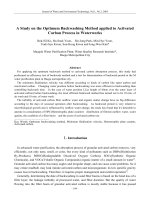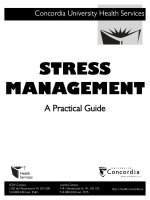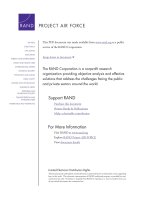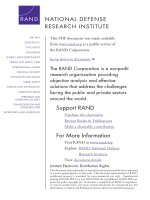ELEGANT ANALYTICAL CHEMISTRY APPLIED TO ENVIRONMENTAL PROBLEMS - A PRACTICAL SYMPOSIUM ppt
Bạn đang xem bản rút gọn của tài liệu. Xem và tải ngay bản đầy đủ của tài liệu tại đây (39.29 KB, 6 trang )
SELECTIVE MONITORING TO ASSESS THE BIOAVAILABILITY
OF ORGANIC CHEMICALS IN AQUATIC SYSTEMS
S. W. Morrall, C. A. Smith, W. M. Begley, D. J. Versteeg and J. M. Rawlings
Human and Environmental Safety Division, The Procter & Gamble Co.,
PO Box 538707, Cincinnati, OH 45253
The risk a chemical poses to the aquatic environment is a function of concentration,
toxicity, and bioavailability. The concentration of a chemical in the environment
represents a maximum dose that is potentially available to an organism. Bioavailability
describes the fraction of this potential dose that the organism actually encounters.
Bioavailability is determined to an extent by physical properties, such as aqueous
solubility, vapor pressure, and partitioning. However, the entire system; biota,
environmental compartment composition, and physico-chemical properties are
intimately related and their interaction ultimately defines the actual dose or
bioavailability of a chemical. We can do a reasonable job of estimating both toxicity,
via laboratory testing, and environmental concentration, by direct measurement and
modeling. However, accurate assessment of the bioavailability of organic compounds
in aquatic systems has remained elusive due to the complexity and variability inherent
to the environment.
In an aquatic system, organic compounds can be in molecular solution, associated
with dissolved organic carbon (DOC), sorbed to colloids, suspended particulates, and
sediment. The chemical is available to different organisms to varying degrees,
depending upon what form it is. For example partitioning from a dissolved phase to
sediment will reduce bioavailability to many fish, but increase availability to organisms
that “graze” on periphyton attached to the sediment. Additional variables that impact
effects to biological organisms and ultimately risk to the ecosystem, include the
physical properties and chemical composition of the aquatic system, route of chemical
exposure to organisms, and form of ionizable molecules. Integration of all these factors
Preprints of Extended Abstracts Vol. 41 No. 1
668
ELEGANT ANALYTICAL CHEMISTRY APPLIED TO ENVIRONMENTAL
PROBLEMS — A PRACTICAL SYMPOSIUM
Organized by
V. Turoski, S.D. Richardson and J. Plude
Symposia Papers Presented Before the Division of Environmental Chemistry
American Chemical Society
San Diego, CA April 1-5, 2001
is needed to understand the bioavailability of organic chemicals in aquatic systems.
This complexity can be reduced in controlled laboratory model systems and with
integrated field sampling techniques. However, one should not forget that bioavailability
and environmental effects are a product of biology and chemistry, and are not fully
described by either discipline alone.
Aquatic Toxicity
In conventional laboratory testing of toxicity to aquatic organisms care is taken to
deliver a constant freely soluble aqueous concentration of test chemical to the
organism. Bioavailability is eliminated from the equation and aqueous concentration is
equivalent to exposure. Toxicity endpoints are expressed in terms of the aqueous
exposure, as opposed to the internal dose or body burden (tissue concentration). One
rationale for this design is that the tests are used to identify potential hazard. This
hazard is placed into context by an environmental risk assessment, which is expressed
as a ratio of an environmental concentration divided by a no observable effect level
(PEC/PNEC). This approach builds conservatism into the risk assessment, because
bioavailability is not accounted for in the environment (PEC) and designed out of the
lab toxicity test (which determines the PNEC). The actual dose of chemical that
reaches the site of toxic action in the organism is unknown. This is reflected in the
myriad of quantitative structure activity relationships (QSAR) based primarily on
descriptors of water to organism partitioning (such as log P or Ko/w) that have been
developed for aquatic toxicity.
The compounds of interest in this research are primarily ingredients formulated into
consumer products that are disposed “down the drain” during routine use. Surfactants,
fragrance materials, disinfecting actives, and small water soluble polymers are among
the compounds considered. A commonality of these “down the drain” chemicals is they
are introduced into the aquatic environment via sewage and waste water treatment
plant (WWTP) effluents. Consequently, they are bound to colloidal and dissolved
organic matter upon dilution into surface waters. While desorption can occur with
dilution, the predominate environmental form is associated with organic material and
can exhibit significantly less bioavailability than the molecular solutions employed in
laboratory testing.
Body Burden and Bioconcentration Factor (BCF)
An alternative approach, that is gaining acceptance, is to express the toxicity endpoint
in terms of tissue concentration (body burden), rather than aqueous concentration.
This enables a relatively direct comparison between controlled laboratory test data and
a complex dynamic environment. In simple terms, the body burden measured in
organisms collected from the environment is divided by the tissue based toxicity value
determined in the lab. This ratio, how much chemical is in the organism versus the
amount known to cause an effect, provides a reasonable estimation of environmental
risk across the variability of environmental and biological parameters mentioned
previously. The “mussel watch” program implemented this past decade is one example
of using feral organisms as biological samplers to monitor chemical body burden. In
Preprints of Extended Abstracts Vol. 41 No. 1
669
practice, collection and sacrifice of organisms from the environment is not always
feasible nor desirable. There are several approaches that enable practical application
of body burden based risk assessment. We are pursuing a combination of placing
(caging) laboratory test organisms in the environment, making laboratory tests more
relevant (similar) to environmental conditions, and selective sampling to determine
bioavailable concentrations in the field. Bioconcentration factor (BCF), the ratio of a
chemical’s concentration in an aquatic organism versus the concentration in
surrounding water at steady state, is the key metric for linking laboratory data to field
reality.
Estimation of Bioavailability using Solid Phase Micro Extraction (SPME)
As the name implies, SPME extracts a very small amount of analyte, which makes it
useful for measuring partitioning in a complex system without perturbing the system.
Several researchers have employed SPME to estimate the bioavailability of
hydrophobic compounds in aquatic systems. In these cases, the SPME fiber is allowed
to equilibrate with the system and is used as a surrogate for the biological organism.
Our approach differs from this “biomimetic” sampling by utilizing SPME as an analytical
tool to estimate the freely soluble fraction, effectively linking lab test data with complex
environmental systems. In order to accomplish this, the sampling time is strictly
controlled to prevent saturation of the fiber and minimize fouling by DOC, which can
alter the adsorption characteristics and selectivity of the fiber. Analyte associated with
DOC is also extracted by the fiber (probably via adsorption of the DOC:analyte
complex) at longer extraction times. Consequently, sampling is typically completed
within 2 minutes, which provides sufficient quantities for HPLC/MS analyses of most
compounds.
The standard laboratory toxicity test water is a reference for assessing relative
differences observed by SPME measurements in natural waters. Distilled water is not a
good reference solvent, as ionic strength, hardness, and pH can effect adsorption,
particularly ionizable and surface active molecules. The experiment is summarized in
Figures 1. The analytical response of linear dodecyl benzene sulfonate (C
12
LAS, a
common surfactant) versus concentration in HQ distilled water, tap water, and river
water. The LAS response (adsorption) is greatly reduced in the HQ water, where there
is no hardness and very low ionic strength. However, response is the same for the tap
and river waters, indicating that LAS has minimal association with DOC or suspended
river water solids. This conclusion was confirmed in experiments where up to 10 mg/L
standard Suwanee River humic acid (ISHS, Minneapolis) had no effect on SPME
response in a 1 mg/L LAS solution. Toxicity testing in both lab and river water is
consisitent with these data, showing little difference between the two.
Preprints of Extended Abstracts Vol. 41 No. 1
670
Figure 1
SPME CALIBRATION STUDY USING C12LAS
WITH HIGH QUALITY, TAP AND RIVER WATERS
LAS Concentration (mg/L)
0 20 40 60 80 100 120
Peak Area
0
1e+5
2e+5
3e+5
4e+5
5e+5
6e+5
HQ Water
Tap Water
River Water
FILE: SPME\CALCOMP.JNB
In contrast, the addition of 10 mg/L humic acid significantly reduced the SPME
response for short chain (C8,10) cationic surfactant in a test water. [Figure 2] The
difference in SPME response for 1mg/L surfactant is approximately twofold, which is
consistent with observed toxicity being ameliorated 50% in actual river water. In
practice, SPME is a useful tool for measuring partitioning in well controlled laboratory
systems. However, we have found that under field conditions significant changes in
SPME fiber properties occur with multiple exposures and they are best limited to single
use applications.
Preprints of Extended Abstracts Vol. 41 No. 1
671
Figure 2
SPME resonse to C8,10 cationic surfactant
with (lower) and without (upper) humic acid.
Concentration of Cationic Surfactant (ug/L)
0 200 400 600 800 1000 1200 1400 1600 1800
Area Ratio
0.0
0.5
1.0
1.5
2.0
Hard Water w/ Humic Acid
Hard Water
linear regression
95% CI
Biomimetic Sampling
A variety of sampling devices have been used to identify pollutants with the greatest
potential for bioaccumulation. Among these are hydrophobic solid phase extraction
media and semi-permeable membrane devices (SPMD). In each case the principle of
the experiment is similar, the device is placed in the field, allowed to reach a steady
state with the surrounding water, then removed for analyses of sorbed components.
Hydrophobic compounds with low Henry’s Law Constants (HLC) are typical of what is
identified in these experiments. Biological processes, such as ingestion (or other routes
of exposure), metabolism, and elimination, are not accounted for in these sampling
schemes. Physical partitioning from an aqueous to a hydrophobic phase is the
dominant mechanism determining what is identified.
Integration of Sampling Approaches in Field Experiments
A combination of water column, SPME, passive SPE, caged organisms, and feral fish
samples were collected downstream from trickling filter (TF) waste water treatment
plants (WWTP) located on small streams in Southwest Ohio and Central Kentucky.
While activated sludge is the dominant WWTP, the TF sites were chosen because it is
a less effective process and effluents contain sufficient levels of chemical to measure in
field studies. Similar measurements were conducted during clean water laboratory
toxicity tests. Bioconcentration factors are used to relate lab tests to field conditions,
and to identify appropriate sampling strategies for estimating bioavailability of specific
Preprints of Extended Abstracts Vol. 41 No. 1
672
chemicals. This is a work in progress with the ultimate goal of developing lab based
toxicity and exposure test systems that will accurately assess the risk new chemicals
pose to aquatic environments.
Selected References
Aquatic Toxicity QSAR
1. Morrall, S. W.; et al(1997) Chapter 21 in “Quantitative Structure-Activity
Relationships in Environmental Sciences-VII”, Schuurmann, G. and Chen, F. eds.,
299-314.
2. Dyer, S. D. et al (2000) Environmental Toxicology and Chemistry, Vol 19, No 3, pp
608-616.
3. Roberts D. W. (1991) Sci Tot Environ 109/110:557-568.
SPME and Biomimetic Extraction
1. Boyd-Bland, A. A. and Pawliszyn, J. B. (1996) Anal. Chem, 68 1521-1529
2. Mayer, P., (2000), “Partitioning Based Approaches to Study Exposure and Effects of
Hydrophobic Organic Substrates” Dissertation Utrecht Unieversity, Utrecht , The
Netherlands.
3. Vaes, W. H. J. et al (1996) Anal. Chem 68, 4463-4467
Preprints of Extended Abstracts Vol. 41 No. 1
673









